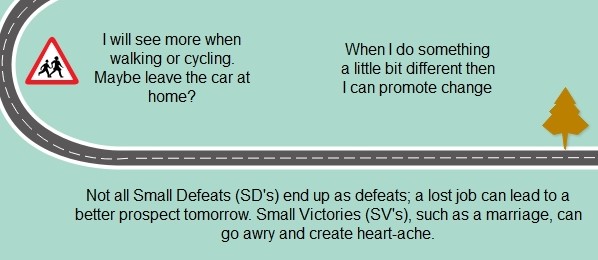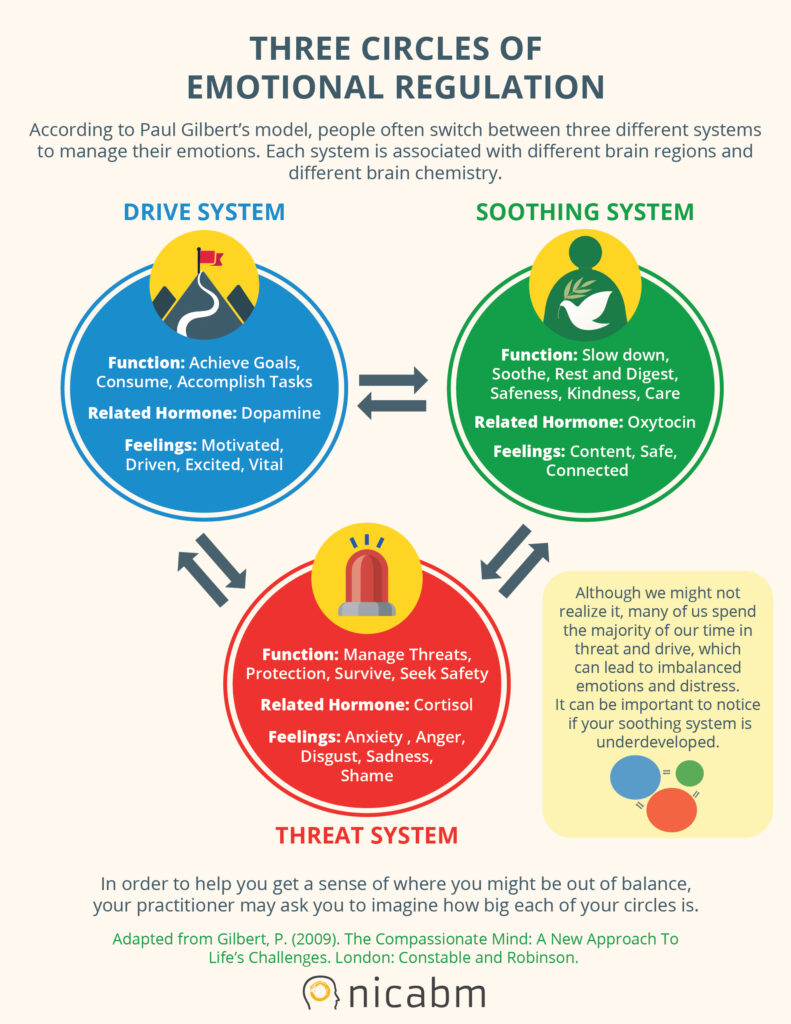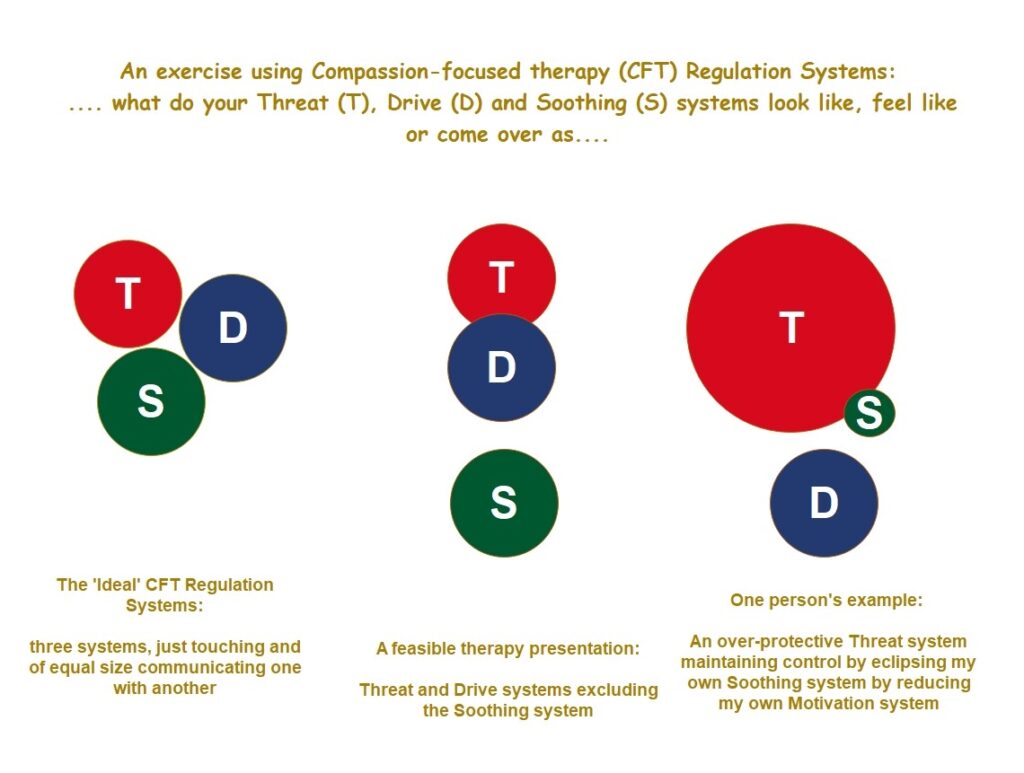I had the opportunity to hear Chris Irons, a UK-based Clinical Psychologist, offer a PESI training in Compassion focused therapy (CFT) on the 25th Nov 2022. His work is well worth further exploration. One way to do this is to get a helpful App from:
Chris Irons’ website: balanced minds: there is a free app and a Premium version with additional features.
In the training, he highlighted how much therapy, and small experimenting, depends on ‘context’; that is, how you change depends on where you are when you seek to make changes, and with whom.
What works in one situation may not work in another. A disagreement with your partner may end a relationship; a disgreement at work need not require your resignation. Over time, small defeats can transform into small victories (and vice versa) as I mention in this part of the scenic route:

He affirmed what I have say elsewhere: CFT integrates a number of approaches to therapy; it is not seeking to be a model in its own right. It is a ‘process’ approach; that is, it is as much about how you do something, as what you do! For an example of process working, take a look at this page on loss and change.
Chris went on to highlight how CFT uses traditional psychological views around attachment, as well as neurology and other more modern revision.
The important thing, as he put it, is the person in front of you. How are the two of you going to explore a new and unique, shared scenic route?
He sees the foundation of CFT being built on relationship and (joint) assessment. The (joint) bit I add to emphasise that technical skills in therapeutic assessment are only of value if you can take some-one else with you! Chris was keen to emphasise the negotiation of a direction for any therapy, and had insufficient time to discuss ‘assessment’ systems.
Once a relationship is formed, and a way forward negotiated, it may be possible to work with a ‘compassionate’ perspective. I say ‘may’ as one obstacle on the scenic route may be our reaction to the very word – compassion.
Chris highlighted an important point; compassion is not an emotion. It is a complex response that involves a range of emotions reacting in a context. That is, it is one thing to feel angry, and it is another thing know what triggers it. Compassion might manifest in care and sensitivity when some-one is physically hurt, yet it might involve assertive boundary-making when I feel unsafe – or some-one else is presenting unsafe behaviour. It all depends …
It ‘ all depends’ on what it means to the people present. Not all compassionate responding is ‘positive’ in the general sense of that word – that is, warm and inviting. Chris’s example of the current wave of social activism all around us was a good one. Irritating people using loud-hailers may be compassionate people if their anger is directed at making us listen to danger signals surrounding us.
Only by checking out the context and outcome of actions is it possible to know whether compassion is in the mix!
In effect, in my language, Chris was reinforcing the value of the small defeat through ‘just noticing‘. He asked us to tolerate how we feel and to name our distress. The ‘context’ may be personal, (your experience) or interpersonal (between you and some-one else) or non-interpersonal (those ‘acts of God’ that arise when you are in the wrong place and the wrong time).
Another step Chris took was to value the educative element of therapy; psycho-education. As I value it as well, I hear the disparagement of ‘education’ in the therapy world; education is represented as ‘telling’ people, not being empathic or accepting of another person. These criticisms show a lack of understanding and experience of adult education.
It was good to hear some-one with a wider understanding. As one of my old bosses said to me decades ago – it’s stuck as you can see: if you have information, the people you work with have a right to that knowledge. She took it as read that those ‘people’ were well in within their rights to let me know their response to it.
It seems to me that a good teacher demonstrates ‘wisdom’ by differentiating between knowledge that needs to be shared, when your experience tell you so – as compared to knowledge that is shared to boost our own ego or vanity.
This was reinforced by Chris who described ‘wisdom’ as “knowledge plus experience“. A good practitioner needed wisdom as compassion is a nuanced experience; it has many faces including commitment, strength and courage.
By the way, I liked his notion that wisdom flows:
From me to you.
From others to me, and
From self to self.
Knowing which is which is helpful as the direction of flow requires me to respect different skills and to attend to different blocks, resistances and obstacles.
Chris’ practical examples lent weight to visualisation work, body scanning and assertiveness as well as motivational exercises.
He said the the CFT Three systems illustration, reproduced below, offers a broader picture on the impact of trauma – encouraging attention to the physiological responses, our behaviour and our changing emotional shifts.
He sees CFT as helping to build resources, encouraging mind and body training as well as affect regulation strategies to unblock any of our eclipsed emotions.
He saw this as putting the compassionate mind to work.
Maybe it’s time to say more about those Three Systems. Briefly mentioned on an older page, the ……
The three CFT systems are
Threat: how do you respond to threats around you? This will involve engaging your Sympathetic system; that element of your autonomic nervous system (ANS) that puts you in an alter state. How often do you use these avoidance and protective responses?
Drive: how do you motivate self-change, and how much energy do you give to this life task? This circle connects very directly with the Transactional Analytic concept of the Driver (and the associated Allowers).
Soothing: how do you calm yourself? This requires you to invite your parasympathetic system to engage. The alternative way to consider this is remind yourself about Stephen Porges’ Social Engagement system. Chris described this system as ‘rest and digest’.
This website makes many references to safety, calming and self-soothing.Much on this website shows how finding a safe place, now, is often neglected in our culture, as well as many others. The Safety or Soothing system is not always valued; it is too often squeezed out. When we have experienced trauma, there is often ‘mileage’ in doing this – when we squeeze things out to avoid the discomfort.
One aim of CFT is to boost this system.
A Safe Experiment
Elsewhere, I have used circles from the Transactional Analytic model to encourage you to identify the ‘size’ and strength of your ego states and life positions.
This present safe experiment encourages us to identify how you would like the proportions and ‘sizes’ of our own CFT systems.
Here CFT and TA both offer asimilar way to track our lives and to stand back and observe both how it is, and how it might be.
The Safe Experiment
Return to your Road Map notes and consider how to track your life using these three circles. It may help to include any work you have done around your ‘ego states’ . Examine how your own ‘PAC’ diagram described on this page: Transactional Analytic differs from the ideal.
Were you able to work on safe experiments to alter the balance in your ego states or life positions? Please bear in mind that these are subjective exercises; the size, proportion and location of each system as you experience them, knowing that they may well vary from day-to-day.
There is no right or wrong.
Let your intuition do the work and put the whole safe experiment down if it is frustrating or becomes too pre-occupying. you can return to it or seek some professional advice if the frustration persists.
Here is one representation of the CFT systems.

How much of your time is spent on these life tasks, as illustrated?
How big are your three circles? How would you prefer them to be …. and how might you make it so.
You can develop your own ideas using my next illustration as a guide. Compare it with the ideal, above, and take time to consider how you would prefer it to be:

As you ask yourself how you might prefer it to be could, consider:
- Where to start getting some small wins to expand the smaller circle?
- How to identify unmet needs so your repetoire of skills expands? This will include building personal ‘resources’ such as affect control, or your ability to communicate assertively. Often practical steps can help here – seeking out courses in mindfulness, relaxation and martial arts.
- What are you reluctant to name? What is avoided or side-stepped in a way that diminishes your Soothing system? This is often an emotion or an option.
Chris offered an number of interesting motivational phrases: such as: grow green to regulate red, meaning our soothing system needs to be bolstered to contain the threats we see ‘too’ often.
He coloured the Threat as Red, Soothing as Green and the Drive system as Blue. An alternative phrase is Grown Green and/or Reduce Red.
The CFT app, as mentioned, should provide a more in-depth guide to developing your own small, safe experiments using Compassion focused therapy.
Please keep in mind that there are no rights or wrongs and there is no strict protocol to follow to find out what works for you. True, it may help to share your thinking and be open to a different perspective and that is what Special Time can do for you. You may find that this work sits alongside some of the Love Languages.
Further leads to consider
The inverted tree: relating to yesterday, today and tomorrow